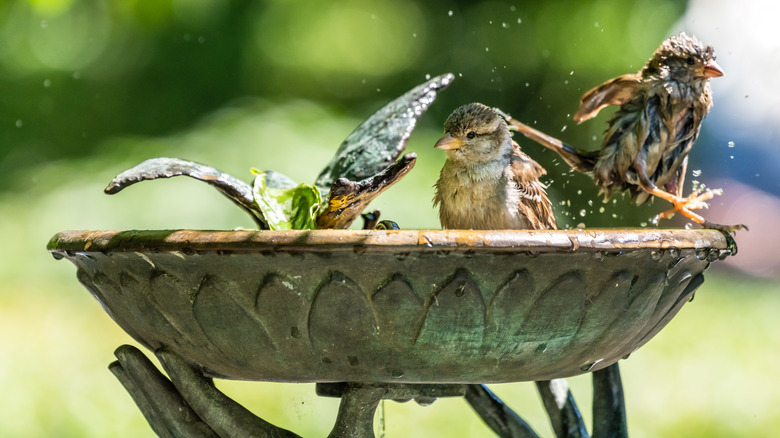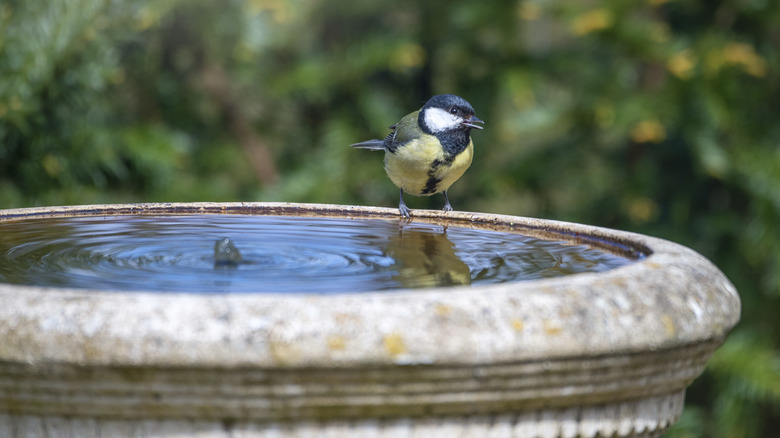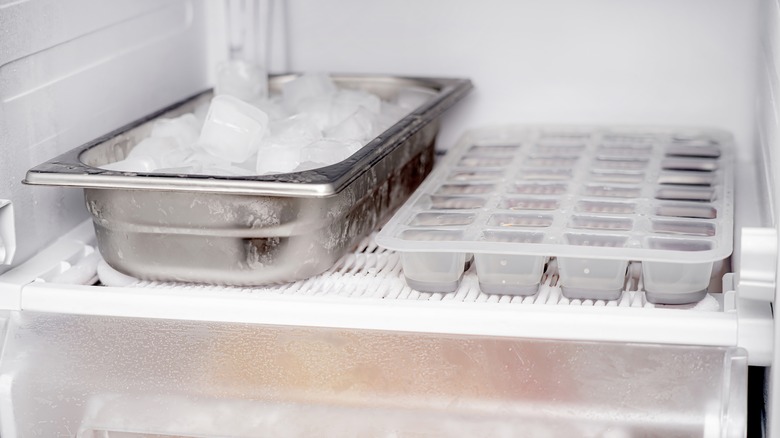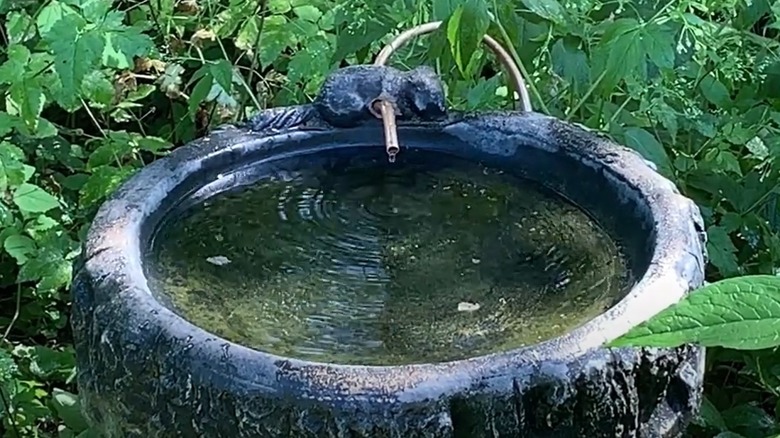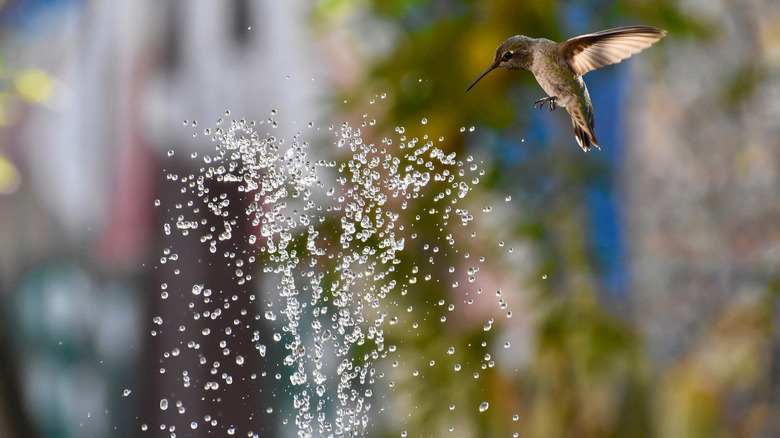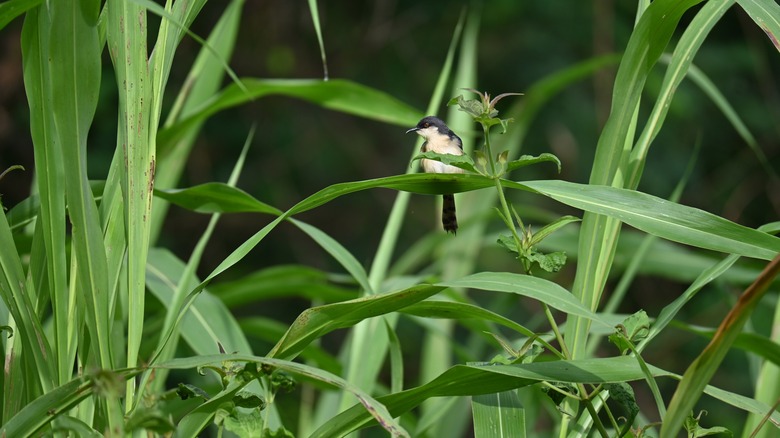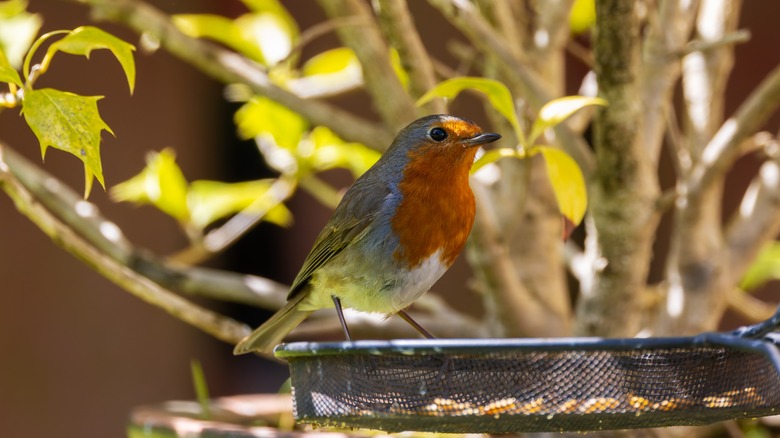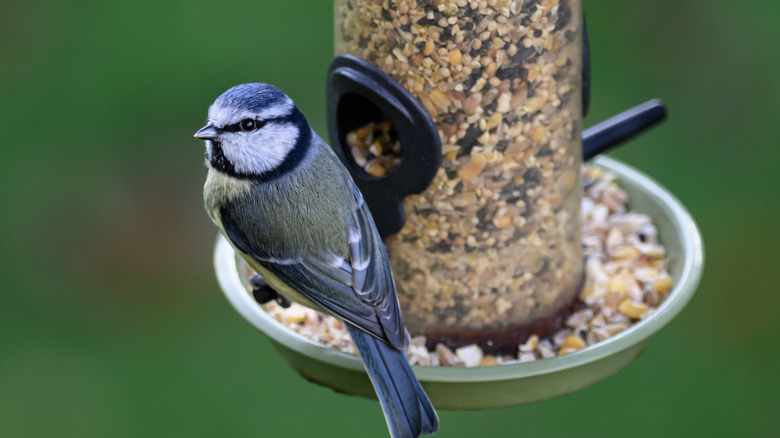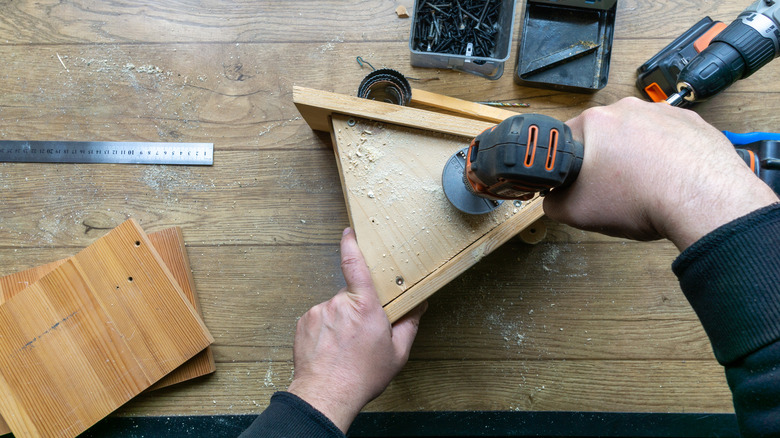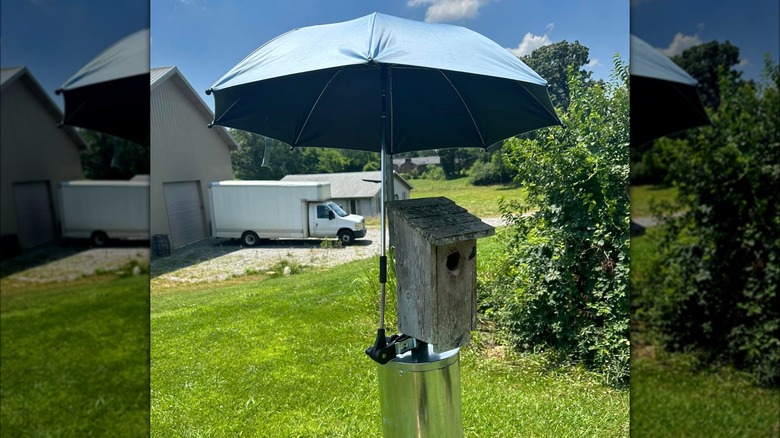Tips & Tricks To Keep Birds Cool And Happy This Summer
When it's hot outside, we all search for ways to stay cool: sitting inside with the air conditioning, heading to the pool or beach, or finding some shade. We aren't the only ones looking for some relief from the heat, though. Our feathered friends also want to stay cool when the outdoor temperature heats up — and they can't just turn on the air conditioning. Fortunately, there are several things you can do to help keep birds more comfortable and happy when they come to visit your backyard this summer.
In an exclusive interview, House Digest talked to two bird experts to help us learn more. Our experts shared ideas and insight that will provide you with actionable tips that you can implement right away to make your yard a refreshing oasis where birds can rest and escape the summer heat. Read on to find the inspiration you need to turn your outdoor space into the coolest spot on the block.
Provide a water source for the birds
In an exclusive interview, Dr. Emma Greig, the Project Leader at the Cornell Lab of Ornithology Project FeederWatch, told House Digest, "One nice way to help birds keep cool is by providing a water source. Bird baths – just a simple shallow tray – are an easy addition to a yard." For those who may not have a stand to place the birdbath on, Dr. Greig says, "you can put it directly on the ground or on a stump."
There are several benefits of adding water to your space. First, the birds will be able to splash in the water, allowing them to cool off on a hot day. Think about how refreshing a dip in the pool feels to you when the temperature is high. You can also add extra features to make it more enticing. Moving water, such as bubblers or streams, makes a distinct sound that is more likely to draw the attention of birds that pass by, inviting them into your space. Plus, because the water isn't stagnant, fountains and other water features with moving water are also less likely to become a breeding area for disease-carrying mosquitoes.
Drop some ice into your water source
While birdbaths and other water features can help birds cool down, the water in them isn't going to stay very cold on a hot day. Even larger birdbaths don't hold a ton of water, so as the day goes on, they are only going to get warmer and warmer as the outdoor temperature rises. Fortunately, there is a simple solution to keep birdbaths cool during the summer: drop some ice into them.
In order for this tip to be most effective, you'll want to use larger blocks of ice. Standard ice cubes will melt slowly, so the cooling effect they provide will be short-lived. Large ice cubes, on the other hand, will take longer to melt, helping to cool the water for a more extended time period. To make a large ice cube, add cold water into a large plastic bowl and pop it in the freezer 12 or more hours before you plan to use it. Consider having a few of these large ice cubes ready if the forecast calls for sweltering heat. As you're preparing ice for your birdbath, you can also make nectar ice cubes to keep your hummingbird feeder cool, too.
Use bird drips to make your birdbath more appealing
In order to attract more birds to your birdbath, Zach Hutchinson, the Head Flocker at Flocking Around, exclusively told House Digest that he recommends using bird drips. He shares, "Bird drips are a great way to keep water moving, cool, and fresh during hot summers." You can add a bird drip to an existing birdbath or set up a new water feature for birds in your yard using one.
Hutchinson explains, "Drips are simple systems that use minimal water and can be purchased or constructed as a simple DIY project." If you want to make your own bird dripper, all you'll need is a garden hose and a thin tube. Connect the tube to the hose and position it about 2 feet (or slightly higher) above the bath. Add an adjustable dripper tip to the end of the tube to ensure only a small amount of water is released at a time. Then, you can connect the hose to the spigot or a rain barrel, if you have one.
Choose the best water source to match the type of birds you want to attract
As you're deciding on the type of water source to add to your backyard, it is important to consider the types of birds you are looking to attract. Certain water sources will be more effective at attracting different types of birds than others. As Dr. Greig explains, "Yes, some birds like to splash in puddles of water, and some (such as hummingbirds) prefer to bathe in a fine mist."
If you are looking to attract hummingbirds, for example, Dr. Greig recommends, "invest[ing] in a fountain that sprays water up a little bit [which the] hummingbirds may be more likely to enjoy that than just a pan of still water." Other types of water sources that are more likely to attract hummingbirds include water misters. The little birds tend to enjoy dashing into the spraying water for some quick relief from the heat.
Leave green spaces in your yard un-trimmed to provide a cooler environment
"An additional idea to help keep spaces cooler during the hottest weeks of the year is to leave green spaces un-trimmed. Yes, not cutting your grass and other ground cover plants creates cooler spaces than a well-manicured lawn," shares Hutchinson. If you do need to trim your bushes or want to mow the lawn, consider waiting until after a heatwave has passed to provide greater refuge for the birds during the hottest periods of the summer.
Longer grass will help with more than just keeping birds cool, too. As Hutchinson explains, "Not only will birds be grateful, but ground-dwelling creatures (i.e. bird food) will appreciate it too." As you're considering your lawn maintenance tasks for the summer, you may also want to skip any chemical pesticides or fertilizers, as these may be toxic to the birds or their sources of food.
Plant a few more shrubs to offer additional shade
To step things up a notch further than simply leaving green spaces untrimmed, you could also consider creating additional shade for the birds. "One thing birds need to stay cool is shade, so having a yard with trees and shrubs will offer them some cover that they need on hot days," explains Dr. Greig. If you don't have ample shrubs or trees already, now might be the time to add a few more to your yard's landscaping. Dr. Greig says, "plant an extra shrub or tree in your yard, and know you are doing something good for the birds!"
Do some research before deciding which shrubs or trees to purchase. Try to stick with native plants to attract birds to your yard. Not only are these adapted to the climate for your area, they will also serve as more suitable shelter and food for regional species. Some of the following shrubs may be suitable options to plant, if they are native to your region: staghorn sumac, northern bayberry, gray dogwood, and winterberry. If you're looking to plant a tree, some good choices may include the eastern red cedar, white oak, flowering dogwood, mulberry, or spruce (just remember to check which species are native to your region).
Provide healthy foods to prevent the birds from exerting excess energy foraging
Foraging for food can be hard work for birds. And, it takes an extra toll on their health and energy levels when it's very hot outside. One way you can help is by providing food for your backyard visitors. Birds typically plan their schedules around the heat, opting to look for food earlier in the morning or later in the evening when the temperatures cool down a bit. So, you can save them the trouble of traveling as far to find nourishment. This will give them more time to splash in the water or rest in the shade on a scorching hot summer day.
To protect the health of the birds, it is essential to offer them healthy foods that will give them the nutrients they need and ensure their metabolism runs as it should. Some foods you can offer in the summer include fruit, nectar, and sunflower seeds. Be sure to frequently swap out any fruits to prevent them from spoiling and threatening the health of the birds. Drying sunflower seeds or any other seeds you offer the birds can also help prevent toxic mold from forming. Storing bird seed properly will keep it fresh and ensure that it stays mold-free.
Add more ventilation to bird boxes
Whether you're DIYing your own birdhouse or have one that you purchased from a store, there is something you can do to ensure it is a cooling retreat for your feathered visitors. While most birdhouses feature integrated ventilation holes, these may not be sufficient on a really hot day. Then, the heat will become trapped in the house, making it very uncomfortable for birds. Proper ventilation, on the other hand, increases airflow throughout the house, allowing the hot air to escape in favor of cooler interior temperatures.
Fortunately, adding some ventilation to a birdhouse is a simple task. All you'll need to do is add a few slits or small holes (using your drill) to the upper sides of the house, just a little below where they meet the roof. Add several of these slits or holes (about ⅛ to ⅜ inches in diameter) to the upper portion of each side to ensure the hot air will be able to escape from the house. If you're worried about rain getting in through the holes, you can drill them at an upward angle. If you live in an area where the winters get very cold, you can also consider plugging these holes when temperatures drop to help the birdhouse stay warmer for the birds.
Add an umbrella above bird houses if they're not shaded in peak afternoon
Ventilation holes or slits will help some with keeping birdhouses comfortable for your feathered friends, but if they are not shaded during the afternoon and the sun is beating down on them, they're still going to be too hot to keep your birds comfortable. If there isn't an alternate location in your yard that offers more natural shade during the heat of the day, you can try adding some shade over the birdhouse. One way to do this is to set up an umbrella so that it covers the house.
If you want to try to provide shade using an umbrella, there are a few important things to keep in mind. First, opt for a lighter colored umbrella as it will reflect more sunlight for an enhanced cooling effect. Then, you'll need to determine a way to keep the umbrella in place. The best way to achieve this goal will vary based on your set up, but cable ties or bungee cords may be able to help you. After setting up the umbrella, observe the behavior of the birds. Some birds may become stressed by the addition, in which case you'll be best just taking it down. Also be sure to remove the umbrella if the forecast calls for thunderstorms or windy conditions.
